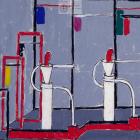Luciano Baldessari (Rovereto, Trento 1896 - Milan 1982), initially trained as an artist and participated in the Futurist movement in Trentino; he then moved to Milan in 1922, where he attained a degree in architecture at the Milan PolytechnicPolitecnico of Milan.
From January 1923 he lived in Berlin, where he worked as a set designer for the theatre and at the same time devoted himself to painting and drawing. He returned to Italy in 1926 where his work in rationalist architecture began. Among the most interesting projects of this period are the mounting of the Silk Exhibition at Villa Olmo (Como) in 1927; the Bernocchi Pavilion at the 10th International Fair of Milan, for which he created a metal dummy "Luminator" (1929); the Craja bar in collaboration with Luigi Figini and Gino Pollini, Fausto Melotti and Marcello Nizzoli; the Print Pavilion of the 5th Triennale (1933); two halls for the Italian Aeronautical Exhibition at the Palazzo dell'Arte in Milan (1934).
From 1939 to the end of World War II he lived in New York where he created stage sets for the theatre, painted and worked in graphic design.
Upon his return to Milan, he designed the atrium and stairway of honour of the 9th Milan Triennale (1951), which required the "direction" of numerous participating artists (among whom Crippa, Dova, Milani, Rossi, Radice).
On this occasion, Lucio Fontana exhibited his famous "Cirro Luminoso", which was hung from the ceiling of the main stairway, and is now on display at the Museo del Novecento in Milan. From 1951 to 1956, Baldessari was commissioned by Breda to design the pavilions at the International Fair of Milan and he called on Lucio Fontana (1953 and 1954), Attilio Rossi (1954) and Umberto Milani (1954) to work on the project. Particularly noteworthy were his mountings of art exhibitions which included: the works of Van Gogh at the Royal Palace of Milan (1953); the Resurgence of Mantua – the House of Mantegna in Mantua (1952), in collaboration with Attilio Rossi; those of Rembrandt and 17th century Dutch Art (1954); Arts & Etruscan Civilization (1955); and Modigliani (1958) at the Royal Palace, with the architect Zita Mosca - his collaborator from 1969, and who later became his wife. Other exhibitions include those of Roberto Crippa (1971), Lucio Fontana (1972) and the exhibition "The Quest for Identity" (1974).








